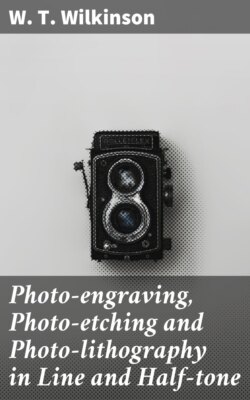Читать книгу Photo-engraving, Photo-etching and Photo-lithography in Line and Half-tone - W. T. Wilkinson - Страница 7
На сайте Литреса книга снята с продажи.
THE NITRATE OF SILVER BATH (1).
ОглавлениеThe silver bath is a most important factor in the production of good negatives. It must be compounded with care and used with skill.
To make it, dissolve 6 ounces of nitrate of silver in 10 ounces of water, then add 10 drops of collodion, and shake up well; then add 70 ounces of water, and let it stand all night; then filter through a pledget of cotton-wool packed loosely in the neck of a glass funnel, into a clean bottle or jug; then add 1 drachm of nitric acid and let stand all night before trying. Such bottle or jug, and also the glass funnel, must be kept solely for use with the silver bath.
The bath holder may be an upright vessel of the ordinary pattern, with a dipper with which to lower the plate into the solution; or it may be a flat dish with a cover to keep out light and dust, using a silver hook to lift the plate from the solution; if the former shape be chosen, let the dipper be of glass, porcelain, silver wire, or of wood soaked in melted paraffine, but on no account of ebonite, as such a dipper will cause spots, and derange the bath sooner or later.
If a flat dish be used, the best form is of wood lined with asphaltum, hanging on a cradle, the lower end being a well to hold the solution; in this form of bath the plate, after sensitizing, is drained thoroughly before taking it out. This is a great convenience, as not only is silver solution saved, but the dark slide will last much longer.
The bath solution made up as above will be the right strength for work, but as every plate sensitized therein, takes away its modicum of silver, after a certain time it must be strengthened, as it is essential for the production of good work that the solution be kept at a proper strength. The best way of doing this is to add a drachm or two of saturated solution of nitrate of silver, after each day’s work has been done, and if the solution be worked in a flat bath, it will be as well to pour it into a jug and filter it before using again; with an upright holder, this filtering will only require to be done about once or twice a week, as any particles of dust, etc., subside and have not the same chance of falling upon the film as in a flat bath; but the addition of the silver solution should be made, and the solution well stirred up with the dipper.
In course of time a silver bath will become contaminated with organic matter from various causes, and can also be supersaturated with ether and alcohol—with iodo-bromo or nitrate of zinc, and will either refuse to work, or only {13} yield imperfect films and thin images. In such cases the best plan will be to take 20 ounces of the solution, dilute it with clean water 60 ounces, filter, and add 6 ounces of nitrate of silver, and again filter, when a new bath will be the result.
The silver in the rejected portion of the old bath should be precipitated as a chloride, by the addition of a solution of common salt, the precipitate dried and sent to a refiner, together with the ashes of the filtering papers and blotting-paper used to drain the plates upon, or to wipe the backs of the plates after leaving the bath and before putting them into the dark slide.
The silver solution named above, is suitable for negatives of subjects in line, but for the production of negatives with delicate half tones, such as portraits, landscapes, or of the many subjects which are photographed direct, then it will be necessary to provide another bath solution, made and managed in the same way, but only containing sufficient nitric acid to just redden litmus paper, as a bath gives the finest half-tones when nearly neutral, or only slightly acid. It should be remembered that the deepest shadows are represented by clear glass in the negative, to insure which would be impossible with the silver solution inclining ever so slightly toward alkalinity.
The nitrate of silver bath may be made up with distilled water, if pure—that is, if the water is bona fide distilled and not merely from waste steam; if this cannot be guaranteed, the best plan will be to get a gallon of tap water, dissolve in it one ounce of nitrate of silver, then add saturated solution of bicarbonate of soda, until an alkaline reaction to litmus paper takes place, then place the lot in white glass bottles, and expose to the action of light for three or four days. During that time the solution will, first of all, turn black, and then will gradually become quite clear, the organic matter—which if not removed, would have caused trouble—falling in a black mass to the bottom.
Now filter the purified water and use it for compounding the nitrate of silver bath, but do not use it for any other purpose.
The strength of a nitrate of silver bath, for line work, should be thirty grains of nitrate of silver to each ounce of water, and should not be allowed to fall below twenty-five; and for half-tone negatives, nitrate of silver should be thirty-five, and not lower than thirty grains to the ounce.
Be sure to keep all funnels, bottles, and dishes used for the silver bath, separate and distinct from all others, and never use them for any other purpose. {14}
